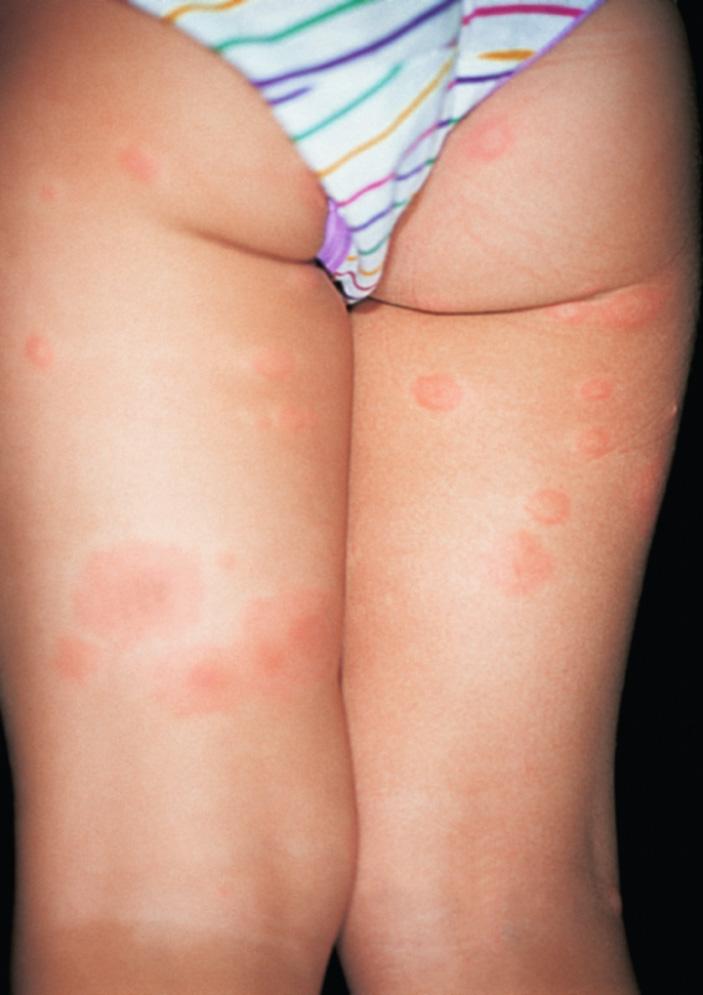Physical Address
304 North Cardinal St.
Dorchester Center, MA 02124
Urticaria, or hives, is divided into acute and chronic forms based on the duration of the hives.
Acute urticaria, by definition, lasts for less than 6 weeks, whereas chronic urticaria lasts more than 6 weeks.
Urticaria is a common, pruritic, distinctive reaction pattern.
Transient, migratory, edematous, pink to red plaques vary in size and shape. Individual lesions typically last less than 24 hours.
The etiology or trigger of most cases of urticaria is undetermined.
Acute urticaria may occur at any age.
It is more common in atopic individuals and is notoriously intensely pruritic.
Hives are caused by histamine release induced by allergens or triggers, such as medications, injections, foods, or airborne allergens.
Angioedema is a histologically deeper variant of urticaria, is somewhat less pruritic, and more commonly affects mucosa.
The edematous plaques are red or pink to flesh-colored and may be surrounded by a white or pink halo.
Individual lesions vary in size, from 2 mm papules to 3 cm or larger wheals.
They are typically round or oval in shape and can become polycyclic and confluent.
The plaques change size and shape and migrate and regress over time.
This is a dynamic process, and new lesions evolve as old ones resolve.
Rarely, bullae or purpuric lesions appear with intense swelling.
The distribution is usually generalized and haphazard.
Linear lesions suggest dermatographism, a type of hive created by scratching.
There are no reliable routine studies for diagnostic confirmation of urticaria.
Biopsy is usually not required for diagnosis of acute hives.
If urticarial vasculitis is suspected, a biopsy can help confirm this diagnosis.
For the most part, urticaria is a clinical diagnosis.
Medication allergy or eruption
Viral exanthem
Bite reaction (papular urticaria)
Bullous pemphigoid (early stages)
Urticarial vasculitis
Hereditary angioedema (mucosal involvement)
All suspected triggers, such as medications, food, inhalants, and injections, should be discontinued.
Antihistamines are typically administered initially: sedating type 1 histamine receptor antagonists (e.g., hydroxyzine [10 mg, 25 mg, 50 mg, 100 mg] 10 mg/5 mL) can be helpful but are limited by drowsiness. They are administered every 4 or 6 hours.
The nonsedating antihistamines (e.g., cetirizine 5 mg, 10 mg) are also helpful but may have to be used in combination with sedating histamine-1 (H 1 )-blocking antihistamines. They are taken once every 24 hours but may be taken twice a day in difficult cases.
Prednisone is rapidly effective and can be given periodically; it may work in patients whose condition is difficult to control with antihistamines.
Combinations of H 1 and H 2 blockers is another treatment strategy.
Doxepin, a tricyclic antidepressant and an antihistamine, can be used in recalcitrant cases.
Epinephrine is administered for extensive, severe cases, but the effects are short-lived.
Cool, soothing baths can be suggested.
Hot showers should be avoided because they worsen the pruritus afterward.
Topical steroids are generally not effective.
Chronic urticaria is defined as urticaria or hives of the skin lasting more than 6 weeks.
This variation of hives requires investigation to the etiology of the urticaria, which can require significant workup.
Chronic urticaria is usually easily diagnosed but presents a treatment and management dilemma.
The underlying cause of chronic urticaria is discovered in only 5% to 25% of cases.
People of all ages are affected, but the highest incidence is in young adults.
The course of the disease is unpredictable, and the disease can last months or years.
Patients should be evaluated for the “five I's”:
Ingestants (most common): medications, foods, additives.
Inhalants: dust, feather, pollen.
Injectants: vaccines, drugs, stings, bites.
Infections: bacterial, viral, fungal, parasitic.
Internal diseases: chronic infections, thyroid disease, lupus erythematosus, occult cancer (rare).
Clinically, chronic and acute urticarias are indistinguishable.
The edematous wheals and plaques are pink to red in color, figurate, and annular, with central clearing.
Lesions vary in size from just millimeters to areas that can cover an entire hand.
These plaques can be coalescing and polycyclic, change in size and shape over time, and migrate.
Individual lesions resolve within 24 hours, whereas new lesions continue to appear.
The cause may be unclear after routine history and physical examination.
Laboratory tests may be ordered but are rarely helpful.
Tests to consider include a complete blood count, sinus radiographs to evaluate for sinusitis, dental radiographs to evaluate for an occult dental abscess, rapid streptococcal test or pharyngeal culture, and a thyroid-stimulating hormone and thyroid microsomal antibody test for autoimmune thyroid disease.
Other tests may be acquired slowly based on the physical signs and symptoms of the patient.
Physical urticaria
Erythema multiforme
Urticarial vasculitis
Bullous pemphigoid (early stages)
Antihistamines (H 1 type) are prescribed initially, most commonly diphenhydramine and hydroxyzine.
They are the backbone of therapy for acute and chronic urticaria.

Hydroxyzine 10 to 25 mg or diphenhydramine 25 to 50 mg can be administered every 4 hours, up to 100 mg every 4 hours as needed, but can be sedating.
Nonsedating antihistamines (H 1 type) should be considered for daytime use and include cetirizine, desloratadine, and fexofenadine.
H 1 -blocking antihistamines may be combined with H 2 -blocking antihistamines, such as cimetidine 400 mg twice daily or ranitidine 150 mg twice daily.
Doxepin, a tricyclic antidepressant and antihistamine, can be prescribed in difficult cases.
Oral steroids are a second line of treatment for hives; however, their use for chronic urticaria is controversial and sometimes detrimental, especially if high doses are required.
Epinephrine is rarely required; the effect is short-lived.
Empiric antibiotic therapy may be tried if an occult infection, such as a tooth abscess, or sinusitis is suspected.
Despite aggressive therapy, many cases of chronic urticaria persist indefinitely.
Become a Clinical Tree membership for Full access and enjoy Unlimited articles
If you are a member. Log in here